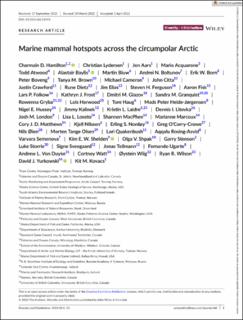| dc.contributor.author | Hamilton, Charmain D. | |
| dc.contributor.author | Lydersen, Christian | |
| dc.contributor.author | Aars, Jon | |
| dc.contributor.author | Acquarone, Mario | |
| dc.contributor.author | Atwood, Todd | |
| dc.contributor.author | Baylis, Alastair | |
| dc.contributor.author | Biuw, Martin | |
| dc.contributor.author | Boltunov, Andrei N. | |
| dc.contributor.author | Born, Erik W. | |
| dc.contributor.author | Boveng, Peter | |
| dc.contributor.author | Brown, Tanya M. | |
| dc.contributor.author | Cameron, Michael | |
| dc.contributor.author | Citta, John | |
| dc.contributor.author | Crawford, Justin | |
| dc.contributor.author | Dietz, Rune | |
| dc.contributor.author | Elias, Jim | |
| dc.contributor.author | Ferguson, Steven H. | |
| dc.contributor.author | Fisk, Aaron | |
| dc.contributor.author | Folkow, Lars | |
| dc.contributor.author | Frost, Kathryn J. | |
| dc.contributor.author | Glazov, Dmitri M. | |
| dc.contributor.author | Granquist, Sandra M. | |
| dc.contributor.author | Gryba, Rowenna | |
| dc.contributor.author | Harwood, Lois | |
| dc.contributor.author | Haug, Tore | |
| dc.contributor.author | Heide-Jørgensen, Mads Peter | |
| dc.contributor.author | Hussey, Nigel E. | |
| dc.contributor.author | Kalinek, Jimmy | |
| dc.contributor.author | Laidre, Kristin L. | |
| dc.contributor.author | Litovka, Dennis I. | |
| dc.contributor.author | London, Josh M. | |
| dc.contributor.author | Loseto, Lisa L. | |
| dc.contributor.author | MacPhee, Shannon | |
| dc.contributor.author | Marcoux, Marianne | |
| dc.contributor.author | Matthews, Cory J. D. | |
| dc.contributor.author | Nilssen, Kjell Tormod | |
| dc.contributor.author | Nordøy, Erling Sverre | |
| dc.contributor.author | O’Corry-Crowe, Greg | |
| dc.contributor.author | Øien, Nils Inge | |
| dc.contributor.author | Olsen, Morten Tange | |
| dc.contributor.author | Quakenbush, Lori | |
| dc.contributor.author | Rosing-Asvid, Aqqalu | |
| dc.contributor.author | Semenova, Varvara | |
| dc.contributor.author | Shelden, Kim E. W. | |
| dc.contributor.author | Shpak, Olga V. | |
| dc.contributor.author | Stenson, Garry | |
| dc.contributor.author | Storrie, Luke | |
| dc.contributor.author | Sveegaard, Signe | |
| dc.contributor.author | Teilmann, Jonas | |
| dc.contributor.author | Ugarte, Fernando | |
| dc.contributor.author | Von Duyke, Andrew L. | |
| dc.contributor.author | Watt, Cortney | |
| dc.contributor.author | Wiig, Øystein | |
| dc.contributor.author | Wilson, Ryan R. | |
| dc.contributor.author | Yurkowski, David J. | |
| dc.contributor.author | Kovacs, Kit M. | |
| dc.date.accessioned | 2022-10-31T08:35:40Z | |
| dc.date.available | 2022-10-31T08:35:40Z | |
| dc.date.created | 2022-09-15T10:34:22Z | |
| dc.date.issued | 2022 | |
| dc.identifier.citation | Diversity and Distributions: A journal of biological invasions and biodiversity. 2022, . | |
| dc.identifier.issn | 1366-9516 | |
| dc.identifier.uri | https://hdl.handle.net/11250/3029003 | |
| dc.description.abstract | Aim: Identify hotspots and areas of high species richness for Arctic marine mammals. Location: Circumpolar Arctic. Methods: A total of 2115 biologging devices were deployed on marine mammals from 13 species in the Arctic from 2005 to 2019. Getis-Ord Gi* hotspots were calculated based on the number of individuals in grid cells for each species and for phyloge-netic groups (nine pinnipeds, three cetaceans, all species) and areas with high spe-cies richness were identified for summer (Jun-Nov), winter (Dec-May) and the entire year. Seasonal habitat differences among species’ hotspots were investigated using Principal Component Analysis. Results: Hotspots and areas with high species richness occurred within the Arctic continental-shelf seas and within the marginal ice zone, particularly in the “Arctic gateways” of the north Atlantic and Pacific oceans. Summer hotspots were generally found further north than winter hotspots, but there were exceptions to this pattern, including bowhead whales in the Greenland-Barents Seas and species with coastal distributions in Svalbard, Norway and East Greenland. Areas with high species rich-ness generally overlapped high-density hotspots. Large regional and seasonal dif-ferences in habitat features of hotspots were found among species but also within species from different regions. Gap analysis (discrepancy between hotspots and IUCN ranges) identified species and regions where more research is required. Main conclusions: This study identified important areas (and habitat types) for Arctic marine mammals using available biotelemetry data. The results herein serve as a benchmark to measure future distributional shifts. Expanded monitoring and teleme-try studies are needed on Arctic species to understand the impacts of climate change and concomitant ecosystem changes (synergistic effects of multiple stressors). While efforts should be made to fill knowledge gaps, including regional gaps and more com-plete sex and age coverage, hotspots identified herein can inform management ef-forts to mitigate the impacts of human activities and ecological changes, including creation of protected areas. | |
| dc.language.iso | eng | |
| dc.title | Marine mammal hotspots across the circumpolar Arctic | |
| dc.title.alternative | Marine mammal hotspots across the circumpolar Arctic | |
| dc.type | Peer reviewed | |
| dc.type | Journal article | |
| dc.description.version | publishedVersion | |
| dc.source.pagenumber | 25 | |
| dc.source.journal | Diversity and Distributions: A journal of biological invasions and biodiversity | |
| dc.identifier.doi | 10.1111/ddi.13543 | |
| dc.identifier.cristin | 2051914 | |
| cristin.ispublished | true | |
| cristin.fulltext | original | |
| cristin.qualitycode | 2 | |
